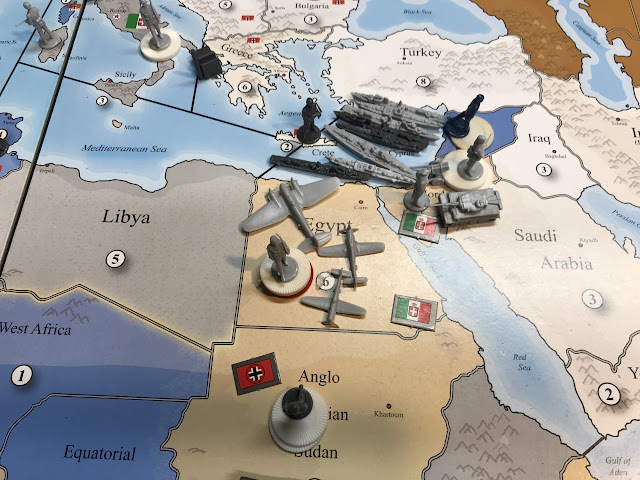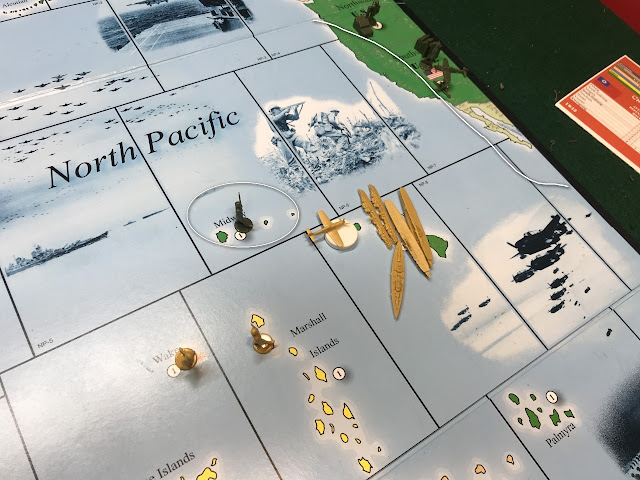A Headless Body Production
Venue: An undisclosed basement
Players: Phil Gardocki running both Axis and Allies.
Game System: The War Game, World War II.
The War Game,World War II, was originally published by Jeffery Stein in 1997.
This version will be using the rules as updated in 2015. See here for the pdf.
For turn 2, see here.
The German/Italian turn
 |
| A note from the previous turn. When British and American bombers caused $23 losses due to Strategic bombing. Out of around $140 |
 |
| On the Russian front, The Romanian army has reinforced Heeresgruppe Sud. This completes the preparation of the German attack the on Caucuses region. |
 |
| With Egypt and Jordan secured, the Italians are ready to explode throughout the Middle East. |
 |
| The Americans have landed in Morocco. |
 |
| Its the Clash of the Titans. The Germans have 14 infantry supported by 3 Panzer Gruppes, and 4 Luftfottes. |
 |
| The Mediterranean wolf pack attacks the invading fleet. |
A game note. Submarines that attack get a "Preemptive shot". Removing casualties before the opposing fleet shots back.
 |
| The Italian forces attack French held Syria, and the Neutral countries of Iraq and Saudi Arabia. |
A game note. To attack a Neutral Country. First the attacking country pays twice it's production value to the bank. So Italy had to pay $6 to attack Saudi Arabia. Then a die is rolled. If the dice is under the production value, then the attacking forces lose 1 unit. In this case, the Italians lost a unit in the Arabian deserts, but just drove into Iraq.
 |
| The Germans take the Caucasus's, but lost far more troops then expected. |
 |
| The allies defeated the axis submarines, losing only a destroyer. And now secure sea dominance in the Atlantic and the Western Mediterranean. |
The Axis heavily reinforced Algeria and Tunis with both new production and shipping.
 |
| But the Axis remains dominant in the eastern Mediterranean. |
 |
| In East Africa, the Africa Korps holds in the Sudan. It could possibly attack and take either Kenya or the Congo, but would be weakened and vulnerable to a counter attack. |
Russian Turn:
 |
| A counter attack like the one in Russia. Led by Zukhov, the Russians throw wave after wave of infantry at German Panzers and guns. Proving the adage, quantity is a quality all it's own. |
 |
| The UK invades Italian held Somalia from India. |
It is now that Malta, that small island in the center of the Mediterranean, decides to play. Malta had been ignored by both Axis and Allies on Turn 1 and 2. Too much trouble to take for the Axis. No enough effect for the Allies to use it.
But 3 freighters offloading troops and tanks in Tripoli is too tempting to ignore. Joined by a destroyer group, fighter bombers from Malta rake the transports. Sinking one on the first strike. Italian aircraft scramble. The second round, Hurricanes and Sagittario dog fight to oblivion. Capronis sink the destroyers. But the damage was done. The Italians lose 2 transports and a fighter. Game cost $35, to a destroyer and a fighter, cost $25.
On "Scrambling". Fighters from adjacent areas can be "Scrambled" to defend adjacent areas. But they do not arrive until the second round of combat.
One further note on Scrambling. Fighters can be scrambled multiple times. So in this case they could scramble to defend the freighters in the sea zone. And if the Americans attack Algeria in their turn, the Fighters can scramble to defend Algeria as well.
 |
Italians scramble their air forces in Libya.
|
 |
| The UK lands Indian troops in Somalia. |
 |
| Churchill double downs on his Norwegian adventure. This time sending Field Marshal Montgomery and 6 units of infantry. |
 |
| British bombers continue their Strategic Bombing campaign. |
 |
| Which was successful. The UK traded 2 fighters for 2 German fighters, and caused $30 (the limit they can cause) of industrial damage. |
 |
| The UK and French is well set to counterattack next turn in Africa. |
Japan:
 |
| The situation so far in China. Japan controls most of the high production value provinces. The Chinese are strong in Kwangtuag, but probably not strong enough. |
 |
Kwangtuag is attacked by land and sea from multiple points. Chaing Kai Shek takes to the field, and with his guidance, kill many Japanese.
|
 |
| In a surprise move, the Japanese amphibiously assault India. |
 |
| The UK are isolated in Burma, surrounded by strong Japanese forces |
America:
America is faced with rapidly reinforced Axis forces in Africa. Attacking would wear the GI's down. There are not enough transports to reinforce Morocco quickly enough.
 |
| But wait. This is only a game. There is enough transport to sea-lift 7 units straight to Italy. Forget Salerno and Anzio. Who cares if we let Morocco fall back into Axis hands. Lets just take Rome, Naples and Genoa in one fell swoop. |
I plead hubris on this one. The Italian reinforcements all went into Africa, leaving Italy ripe for the picking.
 |
| American B-17's fill the sky over France. Escorted by carrier borne F4F fighters against German 88mm flak guns. The fighters and AA trade as losses, but then it was bombers all the way. Causing $30 in strategic bombing damage. |
This means a total loss next turn to Germany of $60, out of around $140.
 |
| The USS Essex carrier group is commissioned, along with supporting destroyers and aircraft. |
What makes this really significant is the 12 submarines operating around Hawaii. If the Japanese want to send their carriers to engage, they will have to risk sub attack, then the Essex will also have land based air to support it.
What makes this really significant is that in addition to building a carrier group, the US also sent $45 to China and Russia as lend lease.
At the beginning of this game I thought the Axis was unstoppable. They were taking high value areas with minor loses. The Germans are creaking. They have taken Leningrad and surrounding areas at a significant cost. But are now taking unacceptable losses from UK and US bombing.This turn $60 in lost production and $40 lost AA and fighters. That doesn't leave a lot left for the attrition war with Russia.
The Japanese still go where they will, And probably will take all of Asia. And may need to attack Russia to save Germany. But most likely, America will build another carrier group in the Pacific, and will have fleet parity there.
Then there is Italy. Probably the mistake the Axis will not be able to recover from.

















































